Related Research Articles

The magnetopause is the abrupt boundary between a magnetosphere and the surrounding plasma. For planetary science, the magnetopause is the boundary between the planet's magnetic field and the solar wind. The location of the magnetopause is determined by the balance between the pressure of the dynamic planetary magnetic field and the dynamic pressure of the solar wind. As the solar wind pressure increases and decreases, the magnetopause moves inward and outward in response. Waves along the magnetopause move in the direction of the solar wind flow in response to small-scale variations in the solar wind pressure and to Kelvin–Helmholtz instability.

The solar wind is a stream of charged particles released from the upper atmosphere of the Sun, called the corona. This plasma mostly consists of electrons, protons and alpha particles with kinetic energy between 0.5 and 10 keV. The composition of the solar wind plasma also includes a mixture of materials found in the solar plasma: trace amounts of heavy ions and atomic nuclei of elements such as C, N, O, Ne, Mg, Si, S, and Fe. There are also rarer traces of some other nuclei and isotopes such as P, Ti, Cr, and 58Ni, 60Ni, and 62Ni. Superimposed with the solar-wind plasma is the interplanetary magnetic field. The solar wind varies in density, temperature and speed over time and over solar latitude and longitude. Its particles can escape the Sun's gravity because of their high energy resulting from the high temperature of the corona, which in turn is a result of the coronal magnetic field. The boundary separating the corona from the solar wind is called the Alfvén surface.

Geophysics is a subject of natural science concerned with the physical processes and physical properties of the Earth and its surrounding space environment, and the use of quantitative methods for their analysis. Geophysicists, who usually study geophysics, physics, or one of the earth sciences at the graduate level, complete investigations across a wide range of scientific disciplines. The term geophysics classically refers to solid earth applications: Earth's shape; its gravitational, magnetic fields, and electromagnetic fields ; its internal structure and composition; its dynamics and their surface expression in plate tectonics, the generation of magmas, volcanism and rock formation. However, modern geophysics organizations and pure scientists use a broader definition that includes the water cycle including snow and ice; fluid dynamics of the oceans and the atmosphere; electricity and magnetism in the ionosphere and magnetosphere and solar-terrestrial physics; and analogous problems associated with the Moon and other planets.

Earth's magnetic field, also known as the geomagnetic field, is the magnetic field that extends from Earth's interior out into space, where it interacts with the solar wind, a stream of charged particles emanating from the Sun. The magnetic field is generated by electric currents due to the motion of convection currents of a mixture of molten iron and nickel in Earth's outer core: these convection currents are caused by heat escaping from the core, a natural process called a geodynamo.

Paleomagnetism is the study of magnetic fields recorded in rocks, sediment, or archeological materials. Geophysicists who specialize in paleomagnetism are called paleomagnetists.
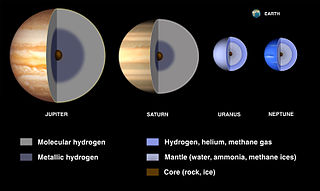
A planetary core consists of the innermost layers of a planet. Cores may be entirely solid or entirely liquid, or a mixture of solid and liquid layers as is the case in the Earth. In the Solar System, core sizes range from about 20% to 85% of a planet's radius (Mercury).
Allan Verne Cox was an American geophysicist. His work on dating geomagnetic reversals, with Richard Doell and Brent Dalrymple, made a major contribution to the theory of plate tectonics. Allan Cox won numerous awards, including the prestigious Vetlesen Prize, and was the president of the American Geophysical Union. He was the author of over a hundred scientific papers, and the author or editor of two books on plate tectonics. On January 27, 1987, Cox died in an apparent suicide.
A geomagnetic reversal is a change in a planet's magnetic field such that the positions of magnetic north and magnetic south are interchanged. The Earth's field has alternated between periods of normal polarity, in which the predominant direction of the field was the same as the present direction, and reverse polarity, in which it was the opposite. These periods are called chrons.
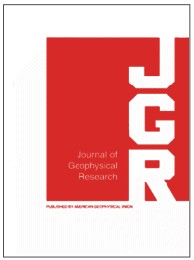
The Journal of Geophysical Research is a peer-reviewed scientific journal. It is the flagship journal of the American Geophysical Union. It contains original research on the physical, chemical, and biological processes that contribute to the understanding of the Earth, Sun, and Solar System. It has seven sections: A, B, C (Oceans), D (Atmospheres), E (Planets), F, and G (Biogeosciences). All current and back issues are available online for subscribers.

In geophysics, a magnetic anomaly is a local variation in the Earth's magnetic field resulting from variations in the chemistry or magnetism of the rocks. Mapping of variation over an area is valuable in detecting structures obscured by overlying material. The magnetic variation in successive bands of ocean floor parallel with mid-ocean ridges was important evidence for seafloor spreading, a concept central to the theory of plate tectonics.
Geomagnetic secular variation refers to changes in the Earth's magnetic field on time scales of about a year or more. These changes mostly reflect changes in the Earth's interior, while more rapid changes mostly originate in the ionosphere or magnetosphere.
Plate reconstruction is the process of reconstructing the positions of tectonic plates relative to each other or to other reference frames, such as the Earth's magnetic field or groups of hotspots, in the geological past. This helps determine the shape and make-up of ancient supercontinents and provides a basis for paleogeographic reconstructions.
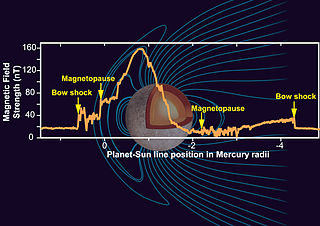
Mercury's magnetic field is approximately a magnetic dipole apparently global, on planet Mercury. Data from Mariner 10 led to its discovery in 1974; the spacecraft measured the field's strength as 1.1% that of Earth's magnetic field. The origin of the magnetic field can be explained by dynamo theory. The magnetic field is strong enough near the bow shock to slow the solar wind, which induces a magnetosphere.
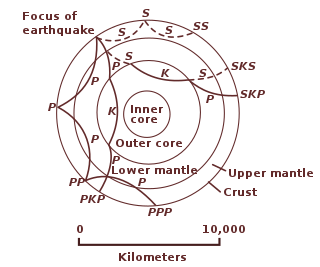
The following outline is provided as an overview of and topical guide to geophysics:
The Laschamp or Laschamps event was a geomagnetic excursion. It occurred between 42,200 and 41,500 years ago, during the end of the Last Glacial Period. It was discovered from geomagnetic anomalies found in the Laschamps lava flows in Clermont-Ferrand, France in the 1960s.

Crustal magnetism is the magnetic field of the crust of a planetary body. The crustal magnetism of Earth has been studied; in particular, various magnetic crustal anomalies have been studied. Two examples of crustal magnetic anomalies on Earth that have been studied in the Americas are the Brunswick magnetic anomaly (BMA) and East Coast magnetic anomaly (ECMA). Also, there can be a correlation between physical geological features and certain readings from crustal magnetism on Earth. Below the surface of the Earth, the crustal magnetism is lost because the temperature rises above the curie temperature of the materials producing the field.
David Breed Beard was a space physicist, known for "pioneering work on the shapes and structures of planetary magnetospheres, Jovian radio emissions, and comets."
Catherine G. Constable is an Australian earth scientist who is a professor at the Scripps Institution of Oceanography. Her research considers palaeo- and geo-magnetism. Constable was awarded the American Geophysical Union William Gilbert Award in 2013 and elected Fellow of the American Association for the Advancement of Science in 2017.
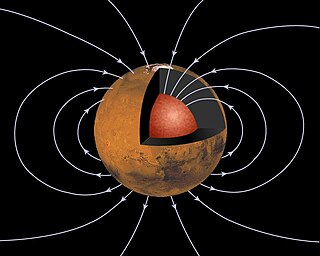
The magnetic field of Mars is the magnetic field generated from Mars' interior. Today, Mars does not have a global magnetic field. However, Mars did power an early dynamo that produced a strong magnetic field 4 billion years ago, comparable to Earth's present surface field. After the early dynamo ceased, a weak late dynamo was reactivated ~3.8 billion years ago. The distribution of Martian crustal magnetism is similar to the Martian dichotomy. Whereas the Martian northern lowlands are largely unmagnetized, the southern hemisphere possesses strong remanent magnetization, showing alternating stripes. Our understanding of the evolution of the magnetic field of Mars is based on the combination of satellite measurements and Martian ground-based magnetic data.
Subir Kumar Banerjee is an Indian-American geophysicist, known for research on rock magnetism, palaeomagnetism, and environmental magnetism.
References
- ↑ "2023 NAS Election".
- 1 2 "Catherine L. Johnson CV at University of British Columbia" (PDF). 2018. Archived (PDF) from the original on 2021-09-12. Retrieved September 12, 2021.
- ↑ "Dr. Catherine Johnson". Planetary Science Institute. Retrieved 2021-09-12.
- 1 2 "Johnson". Honors Program. Retrieved 2021-09-12.
- ↑ Johnson, C. L.; Constable, Catherine G.; Tauxe, Lisa (2003-06-27). "GEOPHYSICS: Mapping Long-Term Changes in Earth's Magnetic Field". Science. 300 (5628): 2044–2045. doi:10.1126/science.1082007. ISSN 0036-8075. PMID 12829772. S2CID 118112727.
- ↑ Johnson, Catherine L.; Constable, Catherine G. (1995-09-01). "The time-averaged geomagnetic field as recorded by lava flows over the past 5 Myr". Geophysical Journal International. 122 (2): 489–519. Bibcode:1995GeoJI.122..489J. doi: 10.1111/j.1365-246X.1995.tb07010.x . ISSN 0956-540X.
- ↑ Johnson, Catherine L.; Constable, Catherine G. (1996-01-15). "Palaeosecular variation recorded by lava flows over the past five million years". Philosophical Transactions of the Royal Society of London. Series A: Mathematical, Physical and Engineering Sciences. 354 (1704): 89–141. Bibcode:1996RSPTA.354...89J. doi:10.1098/rsta.1996.0004. S2CID 84105412.
- ↑ Johnson, Catherine L.; Wijbrans, Jan R.; Constable, Catherine G.; Gee, Jeff; Staudigel, Hubert; Tauxe, Lisa; Forjaz, Victor-H.; Salgueiro, Mário (1998). "40Ar/39Ar ages and paleomagnetism of São Miguel lavas, Azores". Earth and Planetary Science Letters. 160 (3–4): 637–649. Bibcode:1998E&PSL.160..637J. doi:10.1016/S0012-821X(98)00117-4.
- ↑ Johnson, Catherine L.; Purucker, Michael E.; Korth, Haje; Anderson, Brian J.; Winslow, Reka M.; Al Asad, Manar M. H.; Slavin, James A.; Alexeev, Igor. I.; Phillips, Roger J.; Zuber, Maria T.; Solomon, Sean C. (2012). "MESSENGER observations of Mercury's magnetic field structure: MERCURY'S MAGNETIC FIELD STRUCTURE". Journal of Geophysical Research: Planets. 117 (E12): n/a. doi:10.1029/2012JE004217. hdl: 2027.42/96229 . S2CID 15704254.
- ↑ Johnson, C. L.; Phillips, R. J.; Purucker, M. E.; Anderson, B. J.; Byrne, P. K.; Denevi, B. W.; Feinberg, J. M.; Hauck, S. A.; Head, J. W.; Korth, H.; James, P. B. (2015-05-22). "Low-altitude magnetic field measurements by MESSENGER reveal Mercury's ancient crustal field". Science. 348 (6237): 892–895. Bibcode:2015Sci...348..892J. doi:10.1126/science.aaa8720. ISSN 0036-8075. PMID 25953822. S2CID 11088932.
- ↑ May 2015, Charles Q. Choi 07 (2015-05-07). "Mercury's Magnetism May Have Once Rivaled Earth's". Space.com. Retrieved 2021-09-12.
{{cite web}}: CS1 maint: numeric names: authors list (link) - ↑ Johnson, Catherine L.; Mittelholz, Anna; Langlais, Benoit; Russell, Christopher T.; Ansan, Véronique; Banfield, Don; Chi, Peter J.; Fillingim, Matthew O.; Forget, Francois; Haviland, Heidi Fuqua; Golombek, Matthew (2020). "Crustal and time-varying magnetic fields at the InSight landing site on Mars". Nature Geoscience. 13 (3): 199–204. Bibcode:2020NatGe..13..199J. doi:10.1038/s41561-020-0537-x. ISSN 1752-0894. S2CID 211265951.
- ↑ Williams, Matt (2020-05-07). "When Did Mars Lose its Global Magnetic Field?". Universe Today. Retrieved 2021-09-12.
- ↑ Johnson, C (2000). "Lithospheric Loading by the Northern Polar Cap on Mars". Icarus. 144 (2): 313–328. Bibcode:2000Icar..144..313J. doi:10.1006/icar.1999.6310.
- ↑ February 2020, Elizabeth Howell 26 (2020-02-26). "Mars lander reveals new details about the Red Planet's strange magnetic field". Space.com. Retrieved 2021-09-12.
{{cite web}}: CS1 maint: numeric names: authors list (link) - ↑ Williams, Matt (March 9, 2020). "Magnetic Fields Around NASA's Mars Lander Are 10 Times Stronger Than Scientists Expected". ScienceAlert. Archived from the original on 2020-03-09. Retrieved 2021-09-12.
- ↑ "8 tense minutes, and then good news, for UBC planetary scientist involved in Mars landing". CBC. November 26, 2018. Retrieved September 12, 2021.
- ↑ Crawford, Tiffany (January 9, 2018). "UBC researcher to study earthquakes on Mars". vancouversun. Archived from the original on 2017-12-28. Retrieved 2021-09-12.
- ↑ "Edward Bullard Lecture | AGU". www.agu.org. Retrieved 2021-09-12.
- ↑ "RAS Awards 2019". Astronomy & Geophysics. 60 (1): 1.11–1.13. 2019-02-01. doi:10.1093/astrogeo/atz038. ISSN 1366-8781.